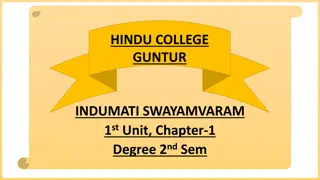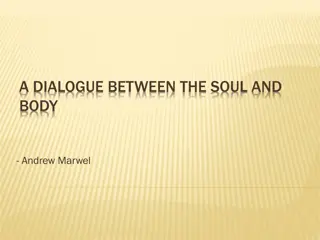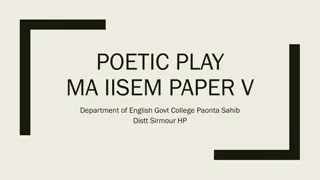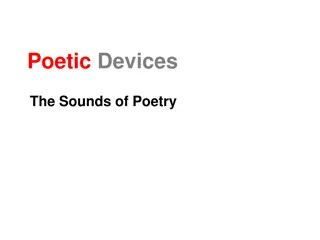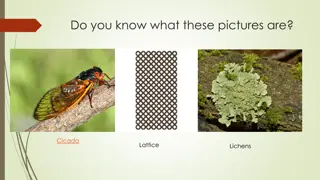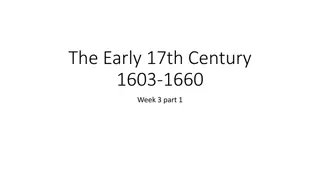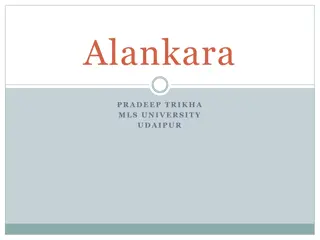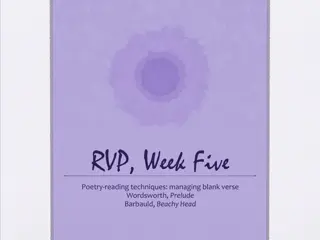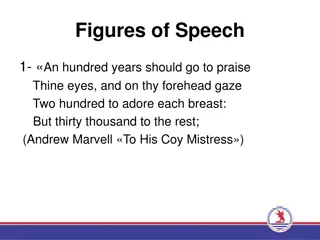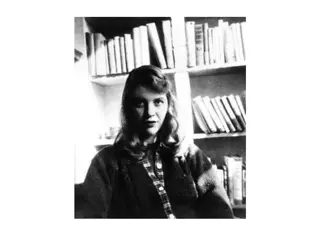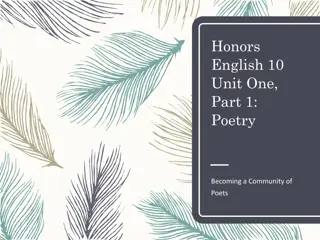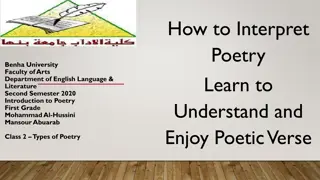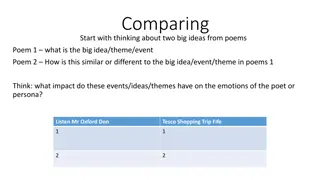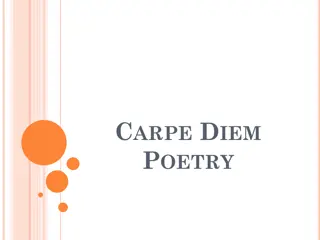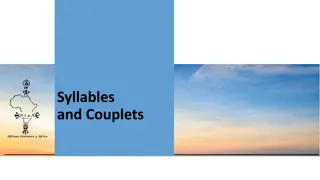Andrew Marvell: Biography and Poetic Works
Portrait of Andrew Marvell, a celebrated English poet, and politician born in 1621. Known for his wit and inventive metaphors, Marvell's life journey and poetic works reflect a fascinating blend of politics, satire, and literary prowess. Explore his background, notable works like "To His Coy Mistress," and his political involvement during a tumultuous era in English history.
Download Presentation

Please find below an Image/Link to download the presentation.
The content on the website is provided AS IS for your information and personal use only. It may not be sold, licensed, or shared on other websites without obtaining consent from the author.If you encounter any issues during the download, it is possible that the publisher has removed the file from their server.
You are allowed to download the files provided on this website for personal or commercial use, subject to the condition that they are used lawfully. All files are the property of their respective owners.
The content on the website is provided AS IS for your information and personal use only. It may not be sold, licensed, or shared on other websites without obtaining consent from the author.
E N D
Presentation Transcript
TO HIS COY MISTRESS TO HIS COY MISTRESS BY BY ANDREW ANDREW MARVELL MARVELL
TABLE OF CONTENTS o The poet: Andrew Marvell Biography Poetical works o The poem: To his coy Mistress Literary genre Title Structure: layout and meter Denotative level Connotative level Themes Inter-textual associations
THE POET: ANDREW MARVELLS BIOGRAPHY Andrew Marvell was born on March, 31 in 1621 in the Winestead-in- Holderness of Yorkshire, England, son of a Church of England clergy men (named Andrew Marvell too). The family moved to Hull because of his father s appointment as Lecturer at Holy Trinity Church in Hull. At age twelve Marvell began his studies at Trinity College in Cambridge. Four years later, he published his first two poems, one in Greek and one in Latin. He received his bachelor s degree in 1939 and he remained at Trinity to complete a master s degree; but he was compelled to abandon his studies in 1641 because his father drowned in the Hull estuary. During the 1640 s Marvell travelled on the continent to improve his linguistic knowledge, he added Dutch, French, Spanish and Italian to the already known Latin and Greek, missing entirely the English Civil War. Marvell spent most of the 1650 s working as a tutor for Mary Fairfax, the Lord General Thomas Fairfax s daughter, who had just relinquished command of the parliamentary army to Cromwell. At this time he lived at Nun Appleton House, where he wrote his probably best known poem: To his coy Mistress.
MARVELLS BIOGRAPHY In 1653 he became the tutor of Cromwell s ward William Dutton, while he also wrote several poems in praise of Cromwell, who was by this time Lord Protector of England. In 1659 Marvell was elected Member of Parliament for Kingston-upon- Hull in the Third Protectorate Parliament. The monarchy was restored to Charles II in 1660. Anyway Marvell held his office in Parliament representing Hull during the Restoration, and he managed to avoid punishment for his own co-operation with republicanism. In addition he helped convince the government of Charles II not to execute John Milton for his antimonarchical writings and revolutionary activities. While Marvel was politically committed, no faction escaped his satirical eyes, in particular he criticized both the court and Parliament. Marvell also wrote anonymous prose satires criticizing the monarchy and Catholicism, defending Puritan dissenters, and denouncing censorship. After 18 years in Parliament, Marvell died of a fever in 1678.
POETICAL WORKS During his lifetime, his prose satires were much better known than his verse. Indeed many of his poems were not published until 1681, three years after his death, from a collection owned by Mary Palmer, his housekeeper. The life and work of Andrew Marvell are both marked by extraordinary variety and range. Marvell shares certain affinities with the metaphysical poets, a group of 17th- century poets who concerned themselves with human experiences on the world. They share common characteristics of wit and inventiveness that surface in their poetry. It is marked by ingenious conceits (extended comparisons that juxtaposes unconventional areas of knowledge), surprising metaphors, puns, paradoxes, and so on. Marvell s style is characterized by elaborate conceits in the elegant style of the metaphysical poets. The outward levity conceals serious argument dealing human experiences, and psychological analysis of human emotions. Marvell's most celebrated lyric, "To His Coy Mistress", combines the serious theme of transience of pleasures, with Marvell's vibrant imagery and easy command of rhyming couplets.
THE POEM Had we but world enough and time, This coyness, lady, were no crime. We would sit down, and think which way To walk, and pass our long love s day. Thou by the Indian Ganges side Shouldst rubies find; I by the tide Of Humber would complain. I would Love you ten years before the flood, And you should, if you please, refuse Till the conversion of the Jews. My vegetable love should grow Vaster than empires and more slow; An hundred years should go to praise Thine eyes, and on thy forehead gaze; Two hundred to adore each breast, But thirty thousand to the rest; An age at least to every part, And the last age should show your heart. For, lady, you deserve this state, Nor would I love at lower rate. But at my back I always hear Time s wing d chariot hurrying near; And yonder all before us lie Deserts of vast eternity. Thy beauty shall no more be found; Nor, in thy marble vault, shall sound My echoing song; then worms shall try That long-preserved virginity, And your quaint honour turn to dust, And into ashes all my lust; The grave s a fine and private place, But none, I think, do there embrace. Now therefore, while the youthful hue Sits on thy skin like morning dew, And while thy willing soul transpires At every pore with instant fires, Now let us sport us while we may, And now, like amorous birds of prey, Rather at once our time devour Than languish in his slow-chapped power. Let us roll all our strength and all Our sweetness up into one ball, And tear our pleasures with rough strife Through the iron gates of life: Thus, though we cannot make our sun Stand still, yet we will make him run.
LITERARY GENRE: LYRIC POETRY Thanks to its style and themes the poem belongs to the literary genre of love lyric poetry. Lyric Poetry is a form of poetry which expresses personal emotions or feelings, typically spoken in the first person.The term derives from a form of Ancient Greek literature, the lyric, which was defined by the musical accompaniment of a lyre. The term owes its importance in literary theory to the division developed by Aristotle between three broad categories of poetry: lyrical, dramatic and epic. In the Renaissance the most finished form of lyric, the sonnet, was brilliantly developed by Petrarch, Shakespeare, Edmund Spenser, and John Milton. Lyric poetry was reworked also in the 17th-century, thanks to poets like John Donne and Andrew Marvell. Especially identified with the lyric form of poetry in the late 18th and 19th centuries were the Romantic poets, including Robert Burns, William Blake, William Wordsworth, John Keats, Victor Hugo, Goethe, and many others.
TITLE: TO HIS COY MISTRESS Lexical choices: Mistress: the word may take different shades depending on the social and cultural contest. In the English lyrical tradition the word mistress refers to the woman loved, desired and courted by the poet, and she usually doesn t correspond his love. It may also mean patron woman a woman having power, authority, or ownership . So the mistress was the woman who has command over the poet s heart. Coy: (from the Latin quietus) The adjective is a key word since it is functional to connote the female figure of the poem in social, psychological and sexual terms. Coyness implies two aspects: the positive one of shyness and modesty and the negative one of prudery and disdain . The bond between the words mistress and coy may convey an imagine of complicated relationship and complex comunication between the poet and his mistress.
STRUCTURE: LAYOUT AND METER The poem consists of 46 lines that follow the rhyme scheme: aa bb cc dd ee ff. Therefore the poem is made up of 23 pairs of lines, also called couplets. The poem s meter is iambic tetrameter: a iamb is a unit of poetry consisting of two syllables, also called a foot . In iambic tetrameter each line has four feet, or eight syllables in total. The poem takes the form of a dramatic monologue, that is a speech by a single character to another fictional one. The speaker s speech follows a clear argumentative structure, defined by the conjunctions and the adverbs If (line 1) that is tacit; if (line 9); but (line 21); then (line 27); now therefore (line 33), thus (line 45). The two beginnigs of a new paragraph define the subdivision of the poem in three sections: lines1-20, lines 21-32, lines33-46. Each sections corresponds to a different temporal condition and vision of the poet.
DENOTATIVE LEVEL The poem is arranged into three sections: each one corresponds to a different temporal condition and vision of the poet. The first section (lines 1-20) is dedicated to the ideal life the speaker would like to live with his mistress. The irrealistic tone is expressed by the use of the conditional tense in expressions like we would sit down I would love you . The second section (lines 21-32) deepens the speaker s pessimistic prevision of the future because of the passing of time that destroys everything. The predominant verbal tense is future thy shall no more than worms shall try . The third section (lines 33-46) is dedicated to the present situation and it includes the speaker s invitation to his mistress to live the moment, and therefore not to be coy.
CONNOTATIVE LEVEL Legend of the rhetorical figures: Legend of the rhetorical figures: Rhetorical figures of meaning (semantic level) Rhetorical figures of meaning (semantic level) Rhetorical figures of word order (syntactical level) Rhetorical figures of sound (phonological level) Rhetorical figures of word order (syntactical level) Rhetorical figures of sound (phonological level) Key words Key words
PARAGRAPH 1: SPEAKERS IMAGINARY WORLD The first section is characterized by an unrealistic tone hypothetical period. It is dedicated to the ideal life his mistress, if they had the eternity in prospect. The main theme is love unrealistic tone, conveyed by the use of the ideal life imagined by the speaker with love. The poem starts with an hypothetical period, in which the conjunction if is tacit: (If)Had we but world , and time. The world world, used in the acceptation of space , is associated to the world time by the conjunction enough that conveys the feeling of shortage. Right from the start the speaker introduces one of the main themes of the poem: passing of time time. The world time is highlighted by a syntactical inversion (anastrophe relevance thanks to its key position at the end of the line. anastrophe), and it acquires If space and time were enough, his mistress coyness would not be a crime. Crime is a juridical term used here in the acceptation of offence that connotes negatively the lady s shy behavior. The speaker s dream is set in a long love s day (contrasting with the previous [not]enough time); by the Indian Ganges side, connected to the idea of wealth and prosperity; and by the side of the Humber, a river flowing in northern England, where Marvell s father drowned. Lines 1 5 Lines 1 5
PARAGRAPH 1 If the lovers had an eternal life in prospect, the speaker could waste his time, complaining for his unrequited love and praising each part of his mistress body for centuries and millenniums. It follows the praising speech of the mistress beauty, typical of courteous love poetry, (here the reader gets a glimpse of Petrarch s influence on English lyric poetry) where the speaker expresses how long it would take to love and praise his mistress. He proceeds through a climax climax of temporal locutions: Ten years before the flood and the conversion of the Jews, that refer to biblical events; an hundred year two hundred years thirty thousand an age at least and the last age (that is Marvell s age). The poet exploits the rhetorical figure of hyperbole reinforce once again the unrealistic tone, but also to add a shade of parody praising speech of the beloved. hyperbole to parody to the The speaker s love is defined vegetable as it could grow slower than an empire. The comparison comparison between the speaker s love and an empire is a great example of ingenious metaphysical conceit. metaphysical conceit. The lauded parts of the mistress body are her eyes, her forehead, her breasts, and the rest, finally her heart. Typical parts of the body praised in lyric poetry are juxtaposed to unusual ones, such as her breasts, that clearly hints to the erotic sphere. Here the poet introduces another main theme of the poem, that is sex (the expression the rest was used by English sonneteers to reference the intimate parts of the body they could not mention). sex Lines 5 20 Lines 5 20
PARAGRAPH 2: PESSIMISTIC PREVISIONS The adversative conjunction but marks the first turning point turning point of the poem: the passage from the ideal and rosy atmosphere of the first paragraph to the pessimistic view of the pessimistic view of the future future, because of the destroying force of time time. destroying force of The speaker always feels Time s winged chariot hurrying behind him (the image derives from the representation of Kronos, Saturn). The expressions at my back and hurrying near convey the idea of a looming dark strength that is rapidly reaching the speaking voice. Its velocity is also reinforced by the use of enjambment enjambment that makes the reading fluent and speed. In front of him, the speaker sees only deserts of vast eternity. The metaphor stands for the eternal empty condition of human beings after death. Marvell s materialistic point of view materialistic point of view excludes any idea of otherworldly life and it probably derives from the classical basis of Lucrezio s De Rerum Natura. The metaphor, highlighted by the enjambment enjambment, combines the concrete image of the desert to the abstract one of eternity, to strengthen and vitalize the concept of death: it is a great example of metaphysical language metaphysical language. metaphor Lines 21 24 Lines 21 24
PARAGRAPH 2 It follows a sequence of pessimistic previsions characterized by the future tense (shall no more be found; shall sound; shall try). The setting of the second paragraph is a gloomy marble grave. In this dark setting, the speaking voice foresees the deterioration of his mistress beauty (Thy beauty shall no more be found) and therefore the decay of his love (into ashes all my lust). According to Marvell s materialistic world vision materialistic world vision, the poet s love depends also from his mistress beauty, since if the latter fades also the former will end. Physical attraction and sexual desire have replaced the stereotype of angle-woman and spiritual love. The second paragraph ends with a comic consideration, where the poet overturns the conventional desire of lovers to stay together forever after death, in the intimate space of a grave. Lines 24 32 Lines 24 32
PARAGRAPH 3: THE PRESENT The adverb now marks the start of the third paragraph and it introduces the reader into the present is characterized by the present tense and it is dedicated to the speaker s invite to live intensely their love invite to live intensely their love, before the coming of death. The argumentative conjunction therefore signs that the speaker has come to a conclusion. present situation. Indeed the last section The present the lovers are living is the time of youth, compared by a simile, to the morning, because of its freshness and vitality. The image of the morning, symbol of youth, is opposite to the arid deserts, symbol of death. Youth is also the time of desire, when the mistress willing soul transpires with instant fires. The adjective willing refers to the lady s hidden desire, and it creates a contradiction with her previous connotation of coy mistress. Her passion is also conveyed by the image of burning fires, usually associated to passionate love connected to the following explicit invitation of the speaker: let us sport while we may, that means let us take our pleasure, make love , like amorous birds of prey. The simile compares the lovers to two birds whose love is instinctive. passionate love. It is strictly Lines 33 38 Lines 33 38
PARAGRAPH 3 The speaker is offering a solution to devour time and not to be devoured, not to languish under his destructive power. By the anaphora Let us, the speaker invites his mistress to gather all their strength and sweetness into a ball, that metaphorically means to merge their love and their passion together. anaphora of the exhortation He invites his mistress to tear their pleasures fighting hardly (with rough strife) through the iron gates of life. In biblical and classical tradition the gates of life were made of ivory, while the gates of death were made of iron. Marvell overturns the convention associating the iron gates to life. Maybe, according to a more risqu interpretation, the word gates may recalls the word grates, that means shutter and fortress, but also vagina, symbol of the mistress chastity the speaker tries to break. Finally, the conjunction thus introduces the conclusion reasoning. Though the lovers can t stop their sun, that scans the days of their love and the passing of time, they can make him run. Finally the lovers can take revenge on time, since the roles are inverted: the sun will run after them and won t manage to overwhelm their love. conclusionof the argumentative Lines 39 44 Lines 39 44
PARAGRAPH 3 Thus, though we cannot make our sun Stand still, yet we will make him run. The last two lines are rich of rhetorical figures. In particular figures of sound such as the alliteration alliteration thus, though; sun, stand, still; we, will; semantic figures such as the oxymoron stand still and run; figures of word order like the parallelism though we cannot make and yet we will make. They are functional to stick the last two epigrammatic lines into the reader s and the lady s mind. oxymoron parallelism In conclusion, the message of the third paragraph may be condensed in the classical expression Carpe Diem Carpe Diem. . Lines 45 46 Lines 45 46
MAIN THEMES Though the outward levity of Marvell s language the poem conceals a deep seriousness of intent, a deep reflection about existential themes. Time Time One of the main theme is clearly passing of time. It s not surprising that Marvell was concerned with time since in the XVII century it was at the centre of scientific and philosophic studies. In particular Marvell was contemporary of both Galileo Galilei and Sir Isaac Newton, who revolutionized the way people thought time. The explicit argument (Marvell s request that the coy lady yield to his passion) is a stalking horse for the more serious argument about transience of pleasure, brevity of happiness and passing of time: in a few words about the theme of Carpe Diem.
MAIN THEMES Mortality and death Mortality and death Another great theme of the poem is mortality, strictly connected to the theme of time. The poet dedicates an entire paragraph to deepen his idea of death, and after death, revealing a radical materialistic point of view. Sex Sex Sex is the major theme of the poem, since one gets a glimpse of sexual allusions all over the poem. Anyway Marvel faces the theme of sex in a poetical way, exploiting ingenious metaphors and similes, sometimes on the border of explicit language. Marvell s contribution perhaps paves the way for more open discussions about sexuality. Surely he opens a debate on the relation between love and sex: does the speaking voice loves his mistress or does he just want to have sex?
INTER-TEXTUAL ASSOCIATIONS The poem presents references to: Classical world: Catullo s carmina; Lucrezio s De Rerum Natura; Ovidios s Metamorfosi; the theme of Carpe Diem and the Greek representation of Kronos on a winged chariot (here the reader can recognize the influence of the poet s education of Greek and Latin roots). Biblical events of the Deluge and the conversion of the Jews. Conventions of courteous love poetry: the reader gets a glimpse of Petrarch s influence on English lyric poetry in the first paragraph, where the poet complains because of his unrequited love and praises his mistress beauty. Metaphysical poetry: the poem shares the main features of metaphysical poetry, thanks to its honesty and unconventionality, and since it reveals the poet s sense of complexities and contradictions of life. It is intellectual, analytical, psychological and bold like the highest examples of metaphysical poetry. Marvell s unconventional praising speech recalls Shakespeare s sonnet 130 My mistress eyes are nothing like the sun: If snow be white, why then her breasts are dun. As Shakespeare, Marvell overturns the conventions of courteous love poetry, marking a break with the literary past.
DECORTE AURORA AND CAVALLARI EVA CLASS 4 ALS School year 2014 2015

 undefined
undefined
























